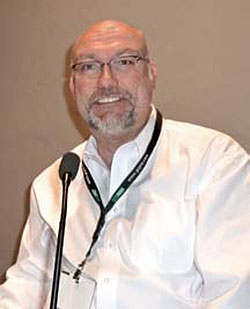
Audience Experience
His perseverance paid off when Electrosound’s Mick Whelan came through Great Gildersleeves on an Elvis Costello tour in 1977. Whelan, who would become one of Leamy’s earliest mentors, was impressed the young house tech.
“He said, ‘I gotta take you with me’,” Leamy laughs. “And I said, ‘sure, sure, now get the hell out of the club and don’t steal anything’.” But less than a week later, Leamy was working a Cheap Trick tour with Whelan.
“In the late 1970s, if you were sober, had a strong back and showed up on time; those were pretty good qualifications for a starting position.”
But Leamy brought far more to the table than that. Fascinated by music and how it could sound so different from venue to venue, he consumed technical information voraciously, taking full advantage of his senior compatriots’ willingness to share their knowledge.
“I gotta tell you, after I was at Electrosound for about six months I thought to myself; if I stay sober, if I don’t do drugs, if I pay attention and learn, I could run this place.”
And he did just that, working his way up from “just a guy slinging loudspeakers” to become the company’s president. “Now some people would say, that’s not something to be proud of, it took you 23 years!”
Throughout his career, Leamy’s approach to system optimization has always centered on the audience experience. “That’s the ultimate arbiter of whether you’ve succeeded or not. I may not have time to be a civilian, but I am able to turn off my technical side and just listen, and I think that’s brought me a lot of success. But paranoia helps, too,” he adds, “and a certain level of low self esteem.”
Clearly, beyond versatile critical listening abilities, he also possesses an often self-deprecating sense of humor, which he says is integral to his leadership style.
“It can be disarming in difficult situations. Laughing while pushing a ‘giant boulder up a hill’ is a good way to motivate others to join in and help.”
That, and his fanatical dedication to getting things done on time and correctly won him the respect of his peers on high profile outings like the Bob Dylan/Tom Petty and the Heartbreakers and Grateful Dead stadium tours in the mid 80s. His work ethic also earned him the nickname of “sergeant major” from Electrosound’s owners.
Practical Things
When it comes to system optimization, Leamy cautions against being overly reliant on instrumentation. “It can be hypnotizing,” he offers, and can distract from serving up what both the audience and the crew want and expect – namely, a great show.
“A bad design is a bad design,” he adds, with the mastery of the mandatory keystrokes of any given technical platform only part of the equation. “That’s why it’s important to look at the practical things. When you’re optimizing a system a lot of people look at the instrumentation and say, ‘well, it tells us this, so that’s the answer.”
“And I reply, ‘well, that doesn’t make any sense. So let’s look at what we did wrong with the test rig.’ I joked earlier that it’s good to be paranoid, to have low selfesteem, but I’m always questioning if it’s really the answer, or if it’s just the first answer that came by.”
To Leamy, good sound is about exceeding expectations, a passion that enabled him to develop leadership qualities that the shy little kid with the amateur radio licenses couldn’t have imagined possessing. These qualities informed his role on many tours, including 1995’s Nine Inch Nails/David Bowie “During the Dissonance” tour.
“It was a great tour, but both acts were on at the same time during the set change – a unique and exciting challenge. So two mixing consoles were live at the same time and they thought for sure there was going to be fistfights among the band’s mixers. So I would go out on the tour as something of a statesmen to keep ‘the peace’ – there were no fistfights on my watch.”
Leamy refers to the leadership roles he’s played at Electrosound, JBL and now Pro Media/UltraSound as “a set of overalls” he puts on, but adds, “I think I have a way of breaking a problem down to its base parts; developing a plan, helping everyone involved understand where the finish line is, and never being afraid to roll up my sleeves and push to get there.”
This also requires an abiding patience – “patience for people,” as he puts it. “Everybody’s got something to offer, and you’ve got to listen as much as you talk.”


